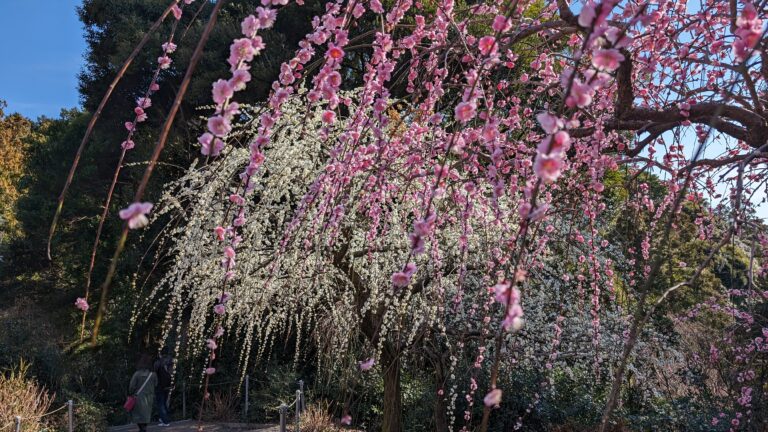Japanese plum flowers, known as “ume” in Japanese, are among the first blossoms to herald the arrival of spring in Japan. While cherry blossoms often steal the international spotlight, plum blossoms hold a special place in Japanese culture with their resilient beauty and enchanting fragrance. These delicate flowers bloom during the coldest part of winter, standing strong against frost and snow, symbolizing perseverance and hope.
This comprehensive guide will take you through everything you need to know about Japanese plum flowers – from their rich cultural history and symbolic meanings to the best viewing spots and ideal times to see them in bloom. Whether you’re planning a trip to Japan during the winter months or simply interested in learning more about these magnificent flowers, this guide has you covered.
What are Japanese Plum Blossoms?
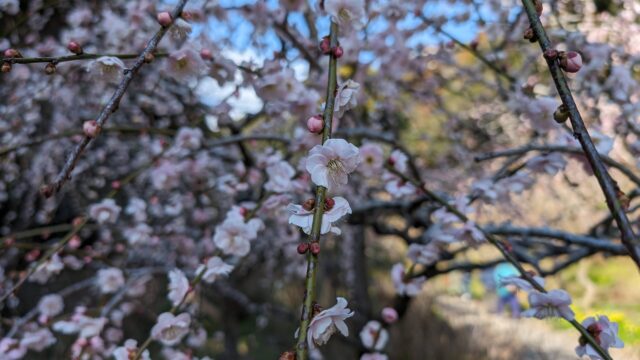
Japanese plum blossoms (ume) are the flowers of the Prunus mume tree, which belongs to the Rose family (Rosaceae) and Prunus genus. Despite its English name “Japanese plum,” it is botanically more closely related to apricots than to European plums, though they all belong to the same Prunus genus. Originally introduced from China about 1,500 years ago, these flowers have become deeply integrated into Japanese culture and aesthetics.
The trees typically reach heights of 4-10 meters and produce stunning five-petaled blossoms in various shades of white, pink, and red. Unlike many other flowering trees, plum blossoms appear directly on the branches without long stems, creating a distinctive and charming appearance. One of their most notable characteristics is their powerful sweet fragrance, which can be detected from a considerable distance even in the cold winter air.
Plum trees are not just ornamental; they also bear fruit that is typically too sour to eat raw but is processed into various traditional Japanese foods and drinks, which we’ll explore later in this article.
History and Cultural Significance
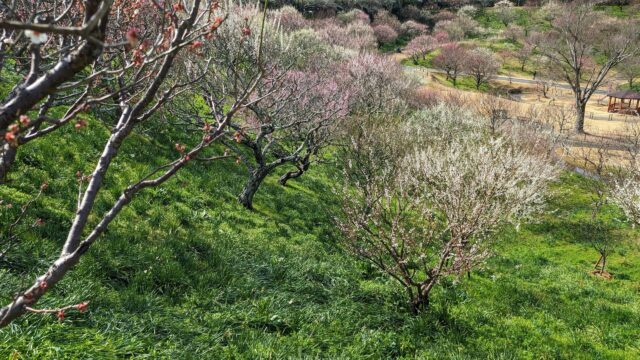
Plum blossoms were introduced to Japan from China during the Nara period (710-794 CE). Initially, they were prized for their medicinal properties, but soon their ornamental value was recognized by the Japanese aristocracy, who began planting them in their gardens.
During the Nara and early Heian periods (794-1185 CE), plum blossoms were actually more celebrated than cherry blossoms. This is evident in Japan’s oldest poetry collection, the Man’yōshū (Collection of Ten Thousand Leaves), which contains about 160 poems about plum blossoms compared to only about 40 about cherry blossoms.
Plum blossoms were the original flower of “hanami” (flower viewing) parties in Japan before cherry blossoms became more popular during the later Heian period. The nobility would gather beneath blooming plum trees to write poetry, drink sake, and appreciate the beauty of the early spring.
One historical figure particularly associated with plum blossoms is the scholar Sugawara no Michizane (845-903 CE). Legend says that when he was exiled from Kyoto, he missed the plum tree in his garden so much that it uprooted itself and flew to join him in Dazaifu, Kyushu. Today, Dazaifu Tenmangu Shrine, dedicated to Michizane, is famous for its 6,000 plum trees.
Types and Characteristics of Plum Blossoms
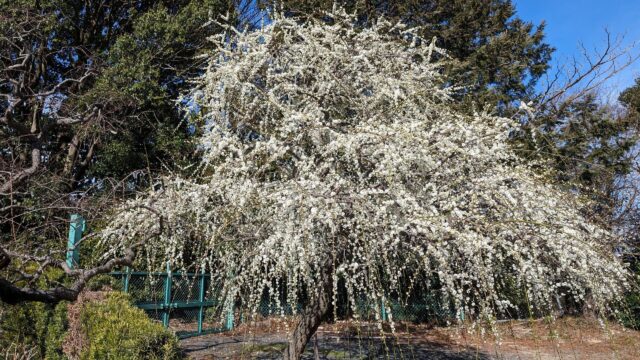
Japanese plum trees come in numerous varieties, developed through centuries of cultivation. Here are some of the main types:
- White plum blossoms (Shirobai): These represent purity and are the most common variety.
- Red or pink plum blossoms (Kobai): These symbolize warmth and passion, ranging from pale pink to deep red.
- Weeping plum (Shidare-ume): These have gracefully drooping branches.
- Double-flowered varieties (Yae-ume): These have extra petals, creating fuller blooms.
Most plum blossoms have five rounded petals, though some cultivated varieties may have more. The flowers appear directly on the branches, without the longer stems seen in cherry blossoms. This gives plum trees a distinctive look, with blossoms seeming to hug the branches.
One of the most notable characteristics of plum blossoms is their enchanting fragrance. Unlike the subtle scent of cherry blossoms, plum blossoms have a strong, sweet aroma that can fill the air, making them a true feast for the senses.
Plum Blossom vs Cherry Blossom
While plum and cherry blossoms might look similar at first glance, there are several key differences that help distinguish between them:
| Feature | Plum Blossoms (Ume) | Cherry Blossoms (Sakura) |
|---|---|---|
| Bloom Time | Late January to March | Late March to April |
| Petals | Round with no splits | Usually have a small notch at the tip |
| Fragrance | Strong, sweet scent | Subtle, faint fragrance |
| Color | White, pink, red | Usually pale pink or white |
| Stems | One blossom per bud, close to branch | Multiple blossoms per bud with longer stems |
| Tree Bark | Often darker with vertical patterns | Usually gray with horizontal lines |
| Leaves | Appear after blooming | Often appear with blossoms |
Another difference is how the flowers bloom on the branches. Plum blossoms appear directly on the branches, while cherry blossoms have longer stems that allow them to hang more freely. This gives cherry trees their characteristic “fluffy” appearance when in full bloom.
Culturally, cherry blossoms have become more closely associated with Japanese identity internationally, while plum blossoms have maintained a slightly more understated, traditional significance in Japanese culture.
Symbolic Meanings of Plum Blossoms
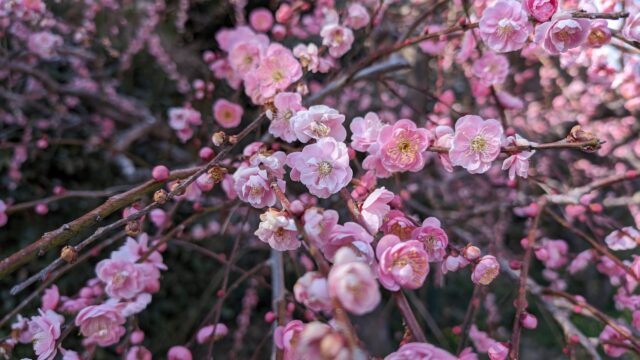
Plum blossoms carry rich symbolic meanings across East Asian cultures. In Japan, they represent:
- Perseverance and resilience: Because they bloom in the coldest part of winter
- Renewal and hope: As harbingers of spring
- Nobility and elegance: Due to their historical association with aristocracy
- Protection: Traditionally believed to ward off evil spirits
The different colors of plum blossoms also carry specific meanings:
- White plum blossoms: Purity, innocence, and truthfulness
- Red plum blossoms: Passion, love, and warmth
- Pink plum blossoms: Happiness, good fortune, and femininity
In Japanese art and literature, plum blossoms are often depicted with other winter motifs such as snow, symbolizing beauty that thrives amidst hardship. They’re also frequently paired with bush warblers (uguisu), small birds whose songs accompany the plum blossom season.
In Korean culture, plum blossoms represent purity and are connected to the scholar’s spirit, while in Chinese culture, they’re one of the “Four Gentlemen” (along with orchids, bamboo, and chrysanthemums) in traditional painting and represent perseverance through the winter.
When to See Plum Blossoms in Japan
Plum blossoms typically bloom earlier than cherry blossoms, making them the first major flowering trees of the year in Japan. Here’s a general timeline for different regions:
- Southern Japan (Kyushu, Shikoku): Late January to mid-February
- Central Japan (Tokyo, Kyoto, Osaka): Mid-February to mid-March
- Northern Japan (Tohoku region): March to early April
- Hokkaido: April to early May
The blooming season for plum blossoms is also longer than that of cherry blossoms. While cherry blossoms typically last only a week or two, plum trees can flower for a month or more, giving visitors a wider window for viewing.
Weather conditions can affect blooming times, with warmer winters leading to earlier blooms. If you’re planning a trip specifically to see plum blossoms, it’s advisable to check the flowering forecasts published by Japanese weather services and tourism websites closer to your travel date.
Many plum blossom festivals (ume matsuri) are held throughout Japan during the blooming season, offering structured opportunities to appreciate these beautiful flowers.
Famous Plum Blossom Viewing Spots in Japan
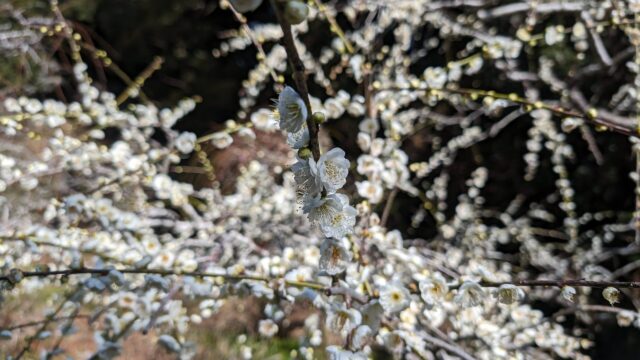
Japan has numerous famous locations for viewing plum blossoms. Here are some of the most renowned:
Tokyo Area
- Yushima Tenjin Shrine: Home to about 300 plum trees and the site of a popular plum festival.
- Koishikawa Korakuen Garden: A historic garden featuring a picturesque plum grove.
- Hanegi Park: Located in Setagaya, with over 650 plum trees and a well-known plum festival.
Kanto Region
- Kairakuen Garden (Mito, Ibaraki): One of Japan’s three most famous gardens, with over 3,000 plum trees of 100 different varieties.
- Odawara Plum Garden (Kanagawa): Features 35,000 plum trees with Mount Fuji as a backdrop.
Kansai Region
- Kitano Tenmangu Shrine (Kyoto): Famous for its 2,000 plum trees in numerous varieties.
- Osaka Castle Park: The plum grove here features about 1,300 trees.
- Tsukigase Plum Grove (Nara): A valley with approximately 10,000 plum trees.
Other Regions
- Dazaifu Tenmangu Shrine (Fukuoka): Associated with Sugawara no Michizane and home to 6,000 plum trees.
- Inabe Plum Grove Park (Mie): Features 4,500 trees and hosts a famous plum festival.
- Atami Plum Garden (Shizuoka): One of the earliest-blooming plum spots in Japan, sometimes flowering as early as December.
Most of these locations host plum festivals during the blooming season, featuring special events, food stalls selling plum-related products, and sometimes evening illuminations that create a magical atmosphere.
Uses of Japanese Plums in Daily Life
Japanese plums (ume fruit) are rarely eaten raw due to their high acidity and sourness. Instead, they’re processed into various traditional foods and drinks:
Umeboshi (Pickled Plums)
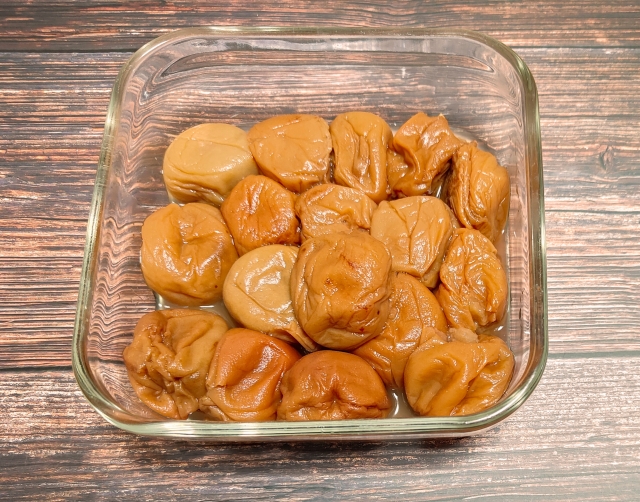
Umeboshi are salt-pickled plums that have become iconic in Japanese cuisine. These sour, salty preserves are often colored with red shiso leaves, giving them their characteristic appearance. They’re traditionally eaten with rice, used in onigiri (rice balls), or enjoyed as a condiment. Umeboshi are believed to have health benefits, including aiding digestion and preventing fatigue.
Umeshu (Plum Wine)

Umeshu is a sweet, fruity liqueur made by steeping green plums in shochu (distilled spirit) or sake with sugar. It’s typically aged for several months to a year, resulting in a sweet, tangy drink that can be enjoyed straight, on the rocks, or diluted with water or soda. Making umeshu at home is a traditional practice in many Japanese households.
Other Plum Products
- Ume syrup: Used in beverages and desserts
- Ume jam: Spread on bread or used in pastries
- Ume candy: Popular sweets with a distinctive sour-sweet flavor
- Ume vinegar: A byproduct of umeboshi production, used in dressings
- Ume tea: Dried plum blossoms can be steeped to make a fragrant tea
Japanese plums also have a long history in traditional medicine, where they’re believed to help with digestive issues, fatigue, and even hangover symptoms.
Conclusion
Japanese plum blossoms represent an often-overlooked treasure of Japan’s floral heritage. Blooming courageously in the depths of winter, these fragrant flowers embody the resilience and quiet beauty that’s so deeply appreciated in Japanese aesthetics.
Whether you’re drawn to their cultural significance, their symbolic meanings, or simply their breathtaking beauty, experiencing Japanese plum blossoms in person is a truly magical experience. While cherry blossoms may get more international attention, the earlier-blooming plum offers visitors a perfect opportunity to enjoy floral beauty without the crowds that gather during cherry blossom season.
If you’re planning a trip to Japan in late winter or early spring, consider including some plum blossom viewing in your itinerary. Not only will you witness one of Japan’s most beautiful natural spectacles, but you’ll also experience a flower viewing tradition that dates back over a thousand years.
The next time someone mentions Japanese flowers, remember that beyond the famous cherry blossoms lies the equally enchanting world of the plum blossom—Japan’s first herald of spring and a symbol of perseverance, hope, and renewal.
